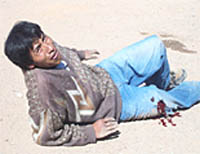Latest update from Peru
by by IMC-UK (posted by Guido) Sunday June 01, 2003 at 02:29 AM
http://belgium.indymedia.org/news/2003/06/66641.php
News from Peru

herido.jpg, JPG image, 200x154
(all links in Spanish) - translated from http://peru.indymedia.org/news/2003/05/1179.php
The declaration of the third of State of Emergency was met with protests against the government. In Trujillo the teachers confronted the police. They are planning a general strike within the next few days to protest against the state of emergency decreed by the central government. The aim of the strike will be the resignation of Alejandro Toledo.
In the Cusco region, teachers did a mock burial of the president. There were demonstrations, some with 'cacerolazos' and actions all over the country. The "Frente de Defensa de Arequipa" decided to call a regional strike of 24 hours on the 3rd of June in demand of the lifting of the state of emergency in the country.
[Some history: http://peru.indymedia.org/news/2003/05/1148.php]
The teachers had been on strike for two weeks by the time the state of emergency was proclaimed. They were demanding a salary increase of 60 dollars a month. On the 26th of May peasants from different zones of the country joined the strike.
As part of the protests, the agricultural workers organized 35 highways blockades in the Autopista Panamericana (pan-american Freeway). On Tuesday 27th of May the strike extended to eight hospitals and to thousands of health centers, meaning 35,000 doctors and nurses asking for salary increases.
Court workers have also been on strike for ten days.
The objective of the state of emergency is to eliminate the blockades of highways, to stop the strikes in the agricultural sector and to reopen the schools. This is why the teachers' strike was declared illegal.
[Some background: http://peru.indymedia.org/news/2003/05/1148.php]
The state of emergency means that the president has powers to suspend or limit individual liberties like the right to strike. The army is allowed to enter the house of any person and can also suspend or limit the right of assembly. In other words, de facto dictatorial powers.
The president held a meeting with businessmen and media owners to discuss the situation and what measures to take. The businessmen support the measures completely. Of course. According to the chancellor, Allan Wagner Tizon, “the investors and the international community” (please read IMF, World Bank and multinational corporations from the US) value the countries where the government has authority and is able to maintain order.
It looks like there is a mass movement in Peru that is becoming something so powerful that the Peruvian dominant classes and the imperialists are frightened. Everything is in a mess. The police and the army have the order to defend the rights of the “majority”. What a strange concept, “majority”! The real majority of the Peruvians – workers, peasants, poor, students – are completely opposed to the politics of the government.
More info in Spanish here: http://peru.indymedia.org/news/2003/05/1180.php, translation to follow
This State of Emergency shows the incapacity of the Government to be able to give political solutions, when confronted by the many social mobilizations in Peru: cocalera federations,lorry drivers, teachers - in a moment of intense internal debate - courts workers, health workers and peasants, irrigation systems users, who achieved the support of the people and the repression of the roads blockades and the marches in all over the country.
Before the state of emergency was proclaimed (although here it says estado de sitio, don't know how to translate this) there were many rumors, in the suburban zones of Lima, of the start of mobilizations of the national police. Most of the complaints to the government are due to its breach of the campaign promises of the President, Alejandro Toledo. When the government condescends to receive spokespeople from the organizations, its offerings either dishonour the agreements of the conversations or these take place under repression . Therefore the state of emergency was dictated and the stoppage by the teachers on 27th of May was declared illegal.The State of Emergency, will last 30 days. 12 of the 24 departments of peru are now under military control and individual rights are suspended : free assembly, inviolability of the residence (that no one has the right to enter your home but on invitation), free traffic in the national territory, not to be detained without express order of a judge or without having been caught while committing a crime. On the first and second days of the emergency, the repression was savage, but the teachers and the people continued to block roads and march in the cities. The rural users of irrigation systems have raised their strike until there are some constitutional guarantees. The repression in the highways is very strong; in Barranca, one provinces south of Lima, the police used lead bullets and left 16 people in hospital, one of them serious.
One of the departments under military control is Puno (on the border with Bolivia). On the 29th of May a student of the National University of the Altiplano, Johny Edy Quilca Cross, 22, was murdered for the FFAA. There are also 40 injured suffering from bullet injuries (shot in the back with live ammunition), and 30 injured by beatings in the wild repression that the police and the army commetted in the University Campus and in the plaza of arms of Puno. Also 4 students have disappeared . On the third day of the state of emergency, according to official figures, 204 people have been arrested. The teachers union says that there are 150 teachers arrested. From what we know and in spite of the state of emergency and the declaration of the teachers' stoppage as illegal, both SUTEP teachers and courts workers in Lima are still on strike and mobilised. Voices calling for the end of the state of emergency are heard louder and louder.